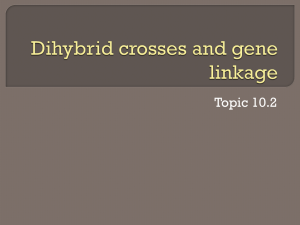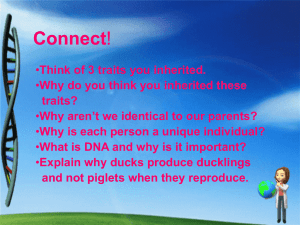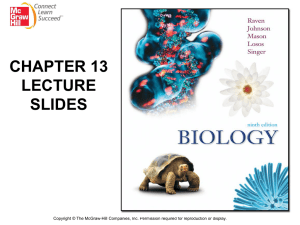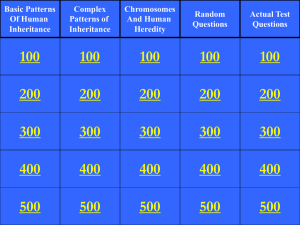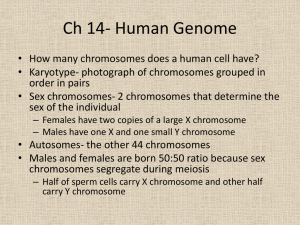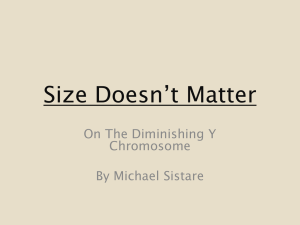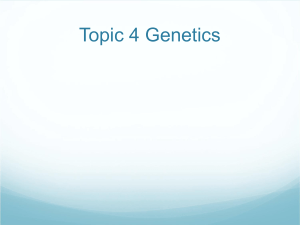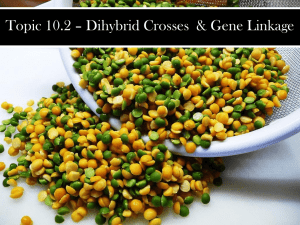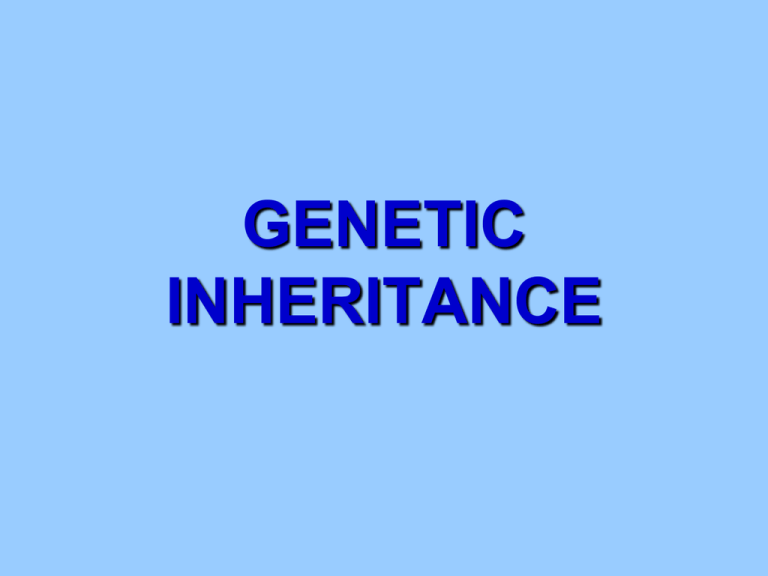
GENETIC
INHERITANCE
Lesson Objectives
At the end of this lesson you should be able to
1. Give a definition for a gamete
2. Understand gamete formation
3. Give the function of gamete in sexual
reproduction
4. Define fertilisation
5. Define allele
6. Differentiate between the terms homozygous
and heterozygous
Lesson Objectives (cont.)
At the end of this lesson you should be able to
6. Differentiate between genotype and phenotype
7. Differentiate between dominant and recessive
8. Show the inheritance to the F1 generation in a cross
involving:
• Homozygous parents
• Heterozygous parents
• Sex determination
• Show the genotypes of parents, gametes and
offspring
Sexual Reproduction
• Involves two parents
• Each parent makes reproductive cells
- called gametes
Outline of Fertilisation
• Gametes join together by fertilisation
• Form a diploid zygote
• This develops into an embryo
• Eventually into a new individual
• New individual resembles both parents
– but is not identical to either
What are Gametes?
• Reproductive Cells
• Formed by meiosis
• Contain single sets of chromosomes
- haploid
• Capable of fusion to form zygote
- diploid
• Zygote contains genetic information of
both gametes
Sex Determination
Human Chromosomes
• We have 46 chromosomes, or 23 pairs.
• 44 of them are called autosomes and are numbered 1
through 22. Chromosome 1 is the longest, 22 is the
shortest.
• The other 2 chromosomes are the sex chromosomes: the
X chromosome and the Y chromosome.
• Males have and X and a Y; females have 2 X’s: XY vs.
XX.
Male Karyotype
Female Karyotype
Sex Determination
The basic rule:
If the Y chromosome is present, the
person is male.
If absent, the person is female.
Meiosis
the X and Y chromosomes separate and go
into different sperm cells:
½ the sperm carry the X and the other half
carry the Y.
All eggs have one of the mother’s X
chromosomes
The Y chromosome has the main sexdetermining gene on it, called SRY
Sex Determination
• About 4 weeks after fertilization, an embryo
that contains the SRY gene develops testes,
the primary male sex organ.
• The testes secrete the hormone
testosterone.
• Testosterone signals the other cells of the
embryo to develop in the male pattern.
Genetics
• The study of heredity.
• Gregor Mendel (1860’s) discovered the
fundamental principles of genetics by breeding
garden peas.
Genetic Terms - Alleles
•
Alternative forms of genes.
•
Units that determine heritable traits.
•
Dominant alleles (TT - tall pea plants)
a. homozygous dominant
•
Recessive alleles (tt - dwarf pea plants)
a. homozygous recessive
•
Heterozygous (Tt - tall pea plants)
Phenotype
• Outward appearance
• Physical characteristics
• Examples:
1.
2.
tall pea plant
dwarf pea plant
Genotype
Arrangement of genes that produces the
phenotype
Example:
1. tall pea plant
TT = tall (homozygous dominant)
2. dwarf pea plant
tt = dwarf (homozygous recessive)
3. tall pea plant
Tt = tall (heterozygous)
Punnett square
A Punnett square is used to show the possible
combinations of gametes.
Breed the P generation
• tall (TT) vs. dwarf (tt) pea plants
T
t
t
T
tall (TT) vs. dwarf (tt) pea plants
T
T
t
Tt
Tt
produces the
F1 generation
t
Tt
Tt
All Tt = tall
(heterozygous tall)
Breed the F1 generation
• tall (Tt) vs. tall (Tt) pea plants
T
T
t
t
tall (Tt) vs. tall (Tt) pea plants
T
T
t
TT
Tt
t
Tt
tt
produces the
F2 generation
1/4 (25%) = TT
1/2 (50%) = Tt
1/4 (25%) = tt
1:2:1 genotype
3:1 phenotype
Monohybrid Cross
• A breeding experiment that tracks the inheritance
of a single trait.
• Mendel’s “principle of segregation”
a. pairs of genes separate during gamete
formation (meiosis).
b. the fusion of gametes at fertilization pairs
genes once again.
Homologous Chromosomes
eye color locus
B = brown eyes
eye color locus
b = blue eyes
This person would
have brown eyes (Bb)
Paternal
Maternal
Meiosis - eye color
B
sperm
B
B
Bb
haploid (n)
b
diploid (2n)
b
b
meiosis I
meiosis II
Monohybrid Cross
• Example:
Cross between two heterozygotes
for brown eyes (Bb)
BB = brown eyes
Bb = brown eyes
bb = blue eyes
B
b
B
Bb x Bb
b
female gametes
male
gametes
Monohybrid Cross
B
b
B
BB
Bb
b
Bb
bb
Bb x Bb
1/4 = BB - brown eyed
1/2 = Bb - brown eyed
1/4 = bb - blue eyed
1:2:1 genotype
3:1 phenotype
Dihybrid
• A genetic cross where two contrasting
traits are investigated
• Eg: TtYy or TTYY
Law of Independent
Assortment
(mendels 2nd law)
• When gametes are formed, each
member of a pair of alleles may
combine randomly with either of another
pair (if genes are not linked)
• The allele for tongue rolling (R) is
dominant to the allele for non tongue
rolling (r). Also the allele for brown hair
(B) is dominant to red hair (b). Neither
of these characteristics is sex linked.
• Using the punnet square determine the
possible F1 generation genotypes of a
cross between two heterozygous
parents (heterozygous for both
characteristics).
• In the fruit fly, Drosophila, the allele for grey
body (G) is dominant to the allele for ebony
body (g) and the allele for long wings (L) is
dominant to the allele for vestigial wings (l).
These two pairs of alleles are located on
different chromosome pairs.
• (i) Determine all the possible genotypes and
phenotypes of the progeny of the following
cross: grey body, long wings (heterozygous for
both) X ebony body, vestigial wings.
Incomplete Dominance
• Niether genes are dominant over the other and
form an intermediate phenotype in the
heterozygous offspring.
• Example: snapdragons (flower)
R
• red (RR) x white (rr)
RR = red flower
rr = white flower
r
r
R
Incomplete Dominance
R
R
r
Rr
Rr
produces the
F1 generation
r
Rr
Rr
All Rr = pink
(heterozygous pink)
Pink Flowers?
Co-dominance
• Both alleles are dominant and both
express their phenotype (multiple alleles) in
heterozygous individuals.
• Example: blood
1.
2.
3.
4.
type A
type B
type AB
type O
=
=
=
=
IAIA or IAi
IBIB or IBi
I A IB
ii
Co-dominance
• Example:
homozygous male B (IBIB)
x
heterozygous female A (IAi)
IB
IB
IA
IA I B
IA IB
i
IB i
IB i
1/2 = IAIB
1/2 = IBi
Practice with Crosses
http://www.zerobio.com/drag_gr11/mono.htm
http://www.brooklyn.cuny.edu/bc/ahp/MGInv/M
GI.Intro.html
Chromosomes and Genetics
Chromosomes are long pieces of DNA, with
supporting proteins
Genes are short regions of this DNA that hold the
information needed to build and maintain the body
Genes have fixed locations: each gene is in a
particular place on a particular chromosome
Diploids have 2 copies of each chromosome, one
from each parent. This means 2 copies of each gene.
Linkage
• genes are genes located on the same
chromosome, which tend to be inherited
together.
Example: Drosophila fruit fly:
• Genes for body colour and wing length are on
the one chromosome i.e. are linked.
• Grey body (G) and long wings (L) are dominant
to black body (g) and vestigial wings (l).
G
with L and g with l.
• Parents:
GGLL
X
ggll
G
•
•
L
•
• Gametes:
•
•
G
•
•
L
• F1:
G
g
g
L
l
l
GL
X
gl
g
l
GgLl
Self-cross (if genes linked):
•
• Parents:
• Gametes:
• F 2:
•
GgLl
GL gl
GGLL
X
GgLl
GgLl
GL gl
GgLl
ggll
• Sex determination
• Autosome: a chromosome other than
the sex chromosomes.
•
• Sex chromosomes: chromosomes that
determine the sex of an individual - XX
or XY.
•
•
•
•
•
•
•
•
•
•
Parents:
Mother
X X
Gametes:
F1 genotype:
Phenotype:
X
(Egg)
XX
Female
X
Father
X Y
X orY (Sperm)
XY
Male
• The male thus determines the sex of an
offspring.
• Mother gives an X to everyone but
father gives an X or Y chromosome.
There is a 50:50 chance that any child
will be male/female)
• In man sex-linked genes (i.e. those on
the X chromosome with no
corresponding part on the Y
chromosome) include those governing
red-green colour blindness, muscular
dystrophy and haemophilia (inability to
clot blood).
• Females with both recessive genes for
haemophilia do not survive beyond the
first four months of gestation period.
• Parents:
•
•
•
• Gametes:
•
Female carrier X
Male normal
XHXh
XHY
XH
Xh
XH
Y
•
•
•
•
•
•
•
F1
XHXH
Female
Normal
XHY
Male
Normal
XHXh
XhY
Female Male
Carrier Haemophili
25% chance of producing a haemophiliac child
50% chance of producing a haemophiliac son.
It is the mother that determines if the son is
haemophiliac or not since the father always
passes the Y chromosome to his son.
• Colour blindness is caused by a recessive gene
on the X chromosome.
•
• Parents:
• Female carrier
X
Male colour blind
End

